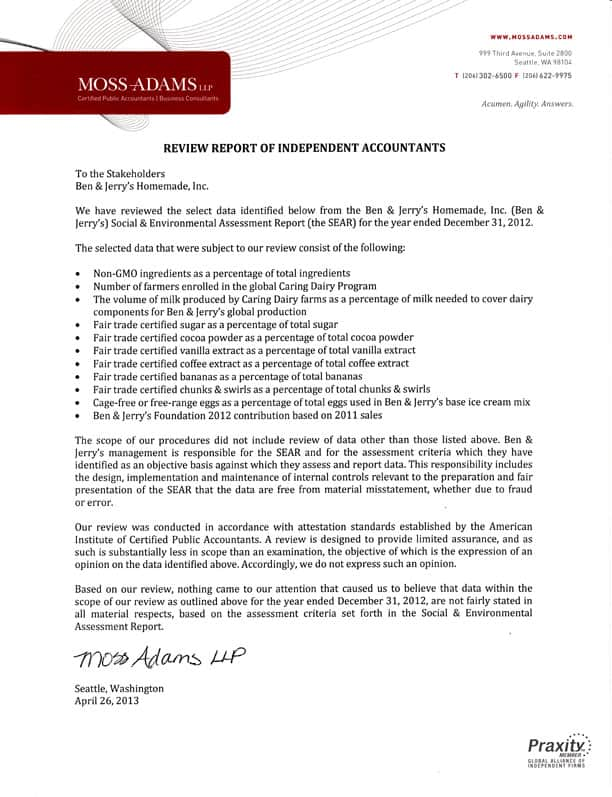2012 Social & Environmental
A LETTER FROM OUR CEO
If you were to come visit us in Vermont, which I invite you to do, you would notice our three-part Mission Statement in the hallways, meeting rooms, individual cubby’s and offices. We wrote it in 1988 to be our north star. The Mission Statement starts off with a preamble that declares, “ Ben & Jerry’s is founded on and dedicated to a sustainable corporate concept of Linked Prosperity.” In 2012, we took the time to gather a cross-section of people within our company, from manufacturing to marketing, to truly sort through what Linked Prosperity means to us in 2012 and how we can make it mean even more in 2013 and beyond. It is an important time for all of us at Ben & Jerry’s to reflect on our Mission and determine how to keep it alive, vigorous and meaningful as we grow both our sales and our social impact around the world.
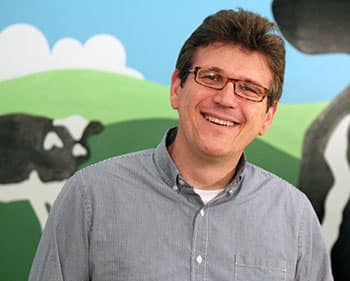
We’re happy to share this report with you in hopes that it might offer some inspiration, some entertainment, and maybe even a few valuable lessons. Most of all, we hope this report helps keep the socially responsible business revolution going!
In a nutshell, 2012 was as complex as a pint of New York Super Fudge Chunk. I’ve been extremely proud of the Ben & Jerry’s global team as it works to live up to our three-part Mission Statement and bring new meaning to our Progressive Values Statement. We spent some time this year turning inward, reflecting on what our business model of a “sustainable concept of linked prosperity” means today and what promise it can offer that we must deliver tomorrow.
We worked hard to meet all three parts of our Mission Statement but realized that our ambitions can easily run up against unforeseen complexities.
Where we focused our activities:
- We decided to go with Fairtrade International in the US to keep Ben & Jerry’s global transition to Fairtrade-certified ingredients under one global system
- We campaigned earnestly to overturn Citizens United and get money out of US politics
- We continued the growth and harmonization within our Caring Dairy™program for dairy farmers in Vermont and the Netherlands
- We fully engaged in a Better Dairy campaign supporting dairy cow welfare in Europe
- We became a certified B Corp, which is recognized as the highest standard for responsible corporate operations
- We supported the next generation of social entrepreneurs through our Join Our Core program
- We continued our support for equal rights for everyone irrespective of race, gender or sexual orientation by supporting a same sex marriage initiative in the UK
Where we temporarily stepped back to reflect and then accelerate:
- We recalibrated our Fair Trade conversion in the US so that in 2013 we could accelerate the conversion and achieve our conversion goal
- We uncharacteristically missed an activism opportunity to support non-GMO labeling in California, but used that lapse to recommit to a consumer’s right to know about GMO’s in their food by supporting all Federal and State-level GMO labeling initiatives, ensuring that we keep our consumers informed via our website and packaging updates and we recommitted to fully converting all of our products to non-GMO sourced ingredients.
I hope you will read more in the 2012 Highlights (Section 1), and perhaps even dig into the details in the full body of the report that follows. I am proud of our progress during 2012 in many areas of our social performance and look forward to raising the bar higher in 2013.
We’re happy to share this report with the intention that it might offer some honest insights and details of our progress. Most of all, we hope this report helps keep the socially responsible business revolution going!
Jostein Solheim
CEO
HIGHLIGHTS IN 2012
Our Three-Part Mission Statement is at our core.
Ben & Jerry’s operates on a three-part mission that aims to create prosperity for everyone that’s connected to our business: suppliers, employees, farmers, franchisees, customers, and neighbors alike.
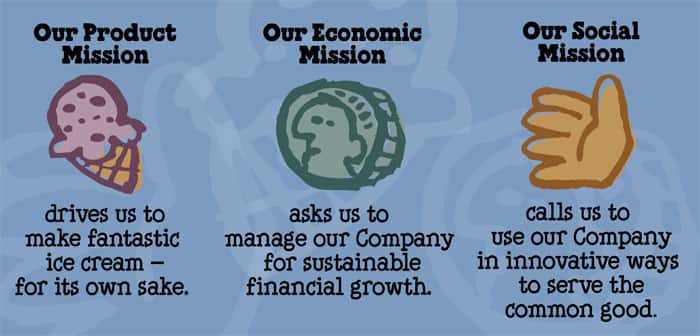
You can read the whole Ben & Jerry’s Mission Statement at www.benjerry.com/values.
A Sustainable Model of Linked Prosperity


We’ve been pioneering a new business model for almost 35 years. Our founders, Ben and Jerry, called it “linked prosperity.” We made a commitment to it in writing in 1988 when we created our unprecedented three-part Mission Statement (see above) . The idea is as simple as it is radical: when the company benefits, all those touched by the company also benefit, including employees, suppliers, customers, and communities.
Over the years, we’ve found many ways to create linked prosperity – through our livable wage and employee benefits; our commitment to family dairy farms, fair trade ingredients and values-led sourcing partnerships such as with Greyston Bakery; contributions to the Ben & Jerry’s Foundation; our activism on social issues; and, of course, all the free ice cream we’ve given away.
Yet we know much more is possible. So where do we go from here?
At the end of 2012, we took pause to reflect on what a sustainable corporate concept of linked prosperity means today and actively explore this question. Ben & Jerry’s Board members, our Global Leadership Team, managers, line-workers and key staff members from our plants and central offices met to begin charting the next phase in our ongoing journey as a values-led business committed to linked prosperity. So, we like to think we ended up 2012 on a positive note, while recognizing that we have a lot of work to do to keep improving on our Social Mission performance.
Values Led Sourcing
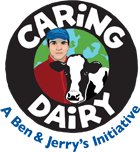 Caring Dairy™. In 2012 we made significant progress in harmonizing global standards for our Caring Dairy™ Program and achieved our goal to fully scale-up the program in Vermont. Today, using a ‘mass-balancing’ approach, Caring Dairy™ farmers in Vermont and the Netherlands produce more than enough of the dairy we need to make our ice cream around the globe! Learn more about Caring Dairy™.
Caring Dairy™. In 2012 we made significant progress in harmonizing global standards for our Caring Dairy™ Program and achieved our goal to fully scale-up the program in Vermont. Today, using a ‘mass-balancing’ approach, Caring Dairy™ farmers in Vermont and the Netherlands produce more than enough of the dairy we need to make our ice cream around the globe! Learn more about Caring Dairy™.
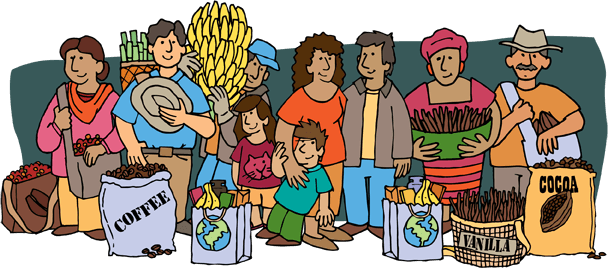
Fair Trade Conversion. In 2012, we needed to redraw the map for our US Fair Trade conversion so that we can still achieve our goal of converting all of our products to Fairtrade-certified. That means that all* of Ben & Jerry’s packaged and scooped products (from bulk containers), globally, will meet Fairtrade International’s requirements for certification.
Our original goal was to complete this conversion by the end of 2013. However, due to the complexity of converting over 100 ingredients in over 200 products that we make, the conversion will continue through 2013 and into 2014. Learn more about our commitment to the fair trade movement. (*No Sugar Added Vanilla Fudge Chip is the only flavor that does not qualify for Fairtrade certification.)
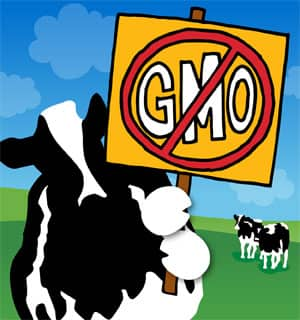 Non-GMO Conversion. In Europe and Asia, Ben & Jerry’s already follows local requirements for non-GMO ingredients (Genetically Modified Organisms). However, in 2012 we pledged to transition our North American sourcing to only non-GMO ingredients for all of our products. By year-end 2012 about 80% of our ingredients, by volume, were non-GMO. That leaves about 20% to convert. The conversion is primarily in our chunks and swirls. However, as with the Fairtrade conversion, it will take us through the balance of 2013 and into 2014 to complete this project, which doesn’t meet our original goal (by the end of 2013), but we are now well on our way to full conversion. Learn more about our conversion to non-GMO sourcingand our position on GMO labeling.
Non-GMO Conversion. In Europe and Asia, Ben & Jerry’s already follows local requirements for non-GMO ingredients (Genetically Modified Organisms). However, in 2012 we pledged to transition our North American sourcing to only non-GMO ingredients for all of our products. By year-end 2012 about 80% of our ingredients, by volume, were non-GMO. That leaves about 20% to convert. The conversion is primarily in our chunks and swirls. However, as with the Fairtrade conversion, it will take us through the balance of 2013 and into 2014 to complete this project, which doesn’t meet our original goal (by the end of 2013), but we are now well on our way to full conversion. Learn more about our conversion to non-GMO sourcingand our position on GMO labeling.
Social and Economic Justice

Get the Dough Out. In 2012 we launched the Get the Dough Out of Politics campaign to increase awareness of the need for fundamental reforms that will reduce or eliminate undue corporate influence in the democratic process and to encourage citizens to take a stand. With our key partners, we mobilized a grassroots effort on college campuses across the country and launched a social media campaign that calls for Congress to overturn Citizens United and get corporate money out of American politics. Learn more about Get the Dough Out.

Join Our Core. In partnership with our friends at Ashoka we launched the Join Our Core competition to find and help support the best young social entrepreneurs across Europe. The competition was the perfect way for Ben & Jerry’s to support young entrepreneurs who share our vision of linked prosperity.
B Corp. A quarter-century after pioneering the socially responsible business movement, Ben & Jerry’s is happy to announce it is the first wholly-owned subsidiary in the world, with full support from our parent Company, Unilever, to gain B Corp Certification. B Corps are a new type of corporation that uses the power of business to solve social and environmental problems. Learn more about Ben & Jerry’s joining the B Corp movement.
Environmental Activism
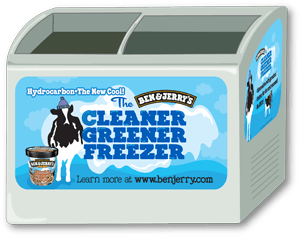
Managing our Environmental Impacts. In 2012, Ben & Jerry’s U.S. business scored 81 out of 100 in its climate impacts ranking by the independent nonprofit Climate Counts, up from 71 in 2010. We also re-engaged in our Ceres-BICEP membership (Business for Innovative Climate & Environmental Policy) by actively participating in BICEP advocacy actions in 2012.
Greener Freezer Roll Out. We continued to roll out more cleaner, greener hydrocarbon (HC) freezers in the US bringing the total in 2012 to 1,090; adding 840 freezers to the 2011 total.
Measuring What Matters: Fine Tuning Our Metrics Model
Ben & Jerry’s has been issuing public reports on our social and environmental activities since 1989. In the past few years, Ben & Jerry’s has been working to develop a better way to measure our Company’s progress towards achieving Social Mission and environmental goals. 2012 is the third year we are using our Quality of Results (QoR) framework for this measure.
The primary purpose of the QoR is to give Ben & Jerry’s management, Ben & Jerry’s Board of Directors, Unilever management and you a clear scorecard by which to evaluate the Company’s social and environmental performance. We made some gains in 2012 over 2011 for our overall QoR numbers. We’re proud of that progress, but know there’s much work to be done.

The QoR measures specific goals for our social and environmental performance within 13 priorities of our business. For our 2012 report, we engaged Moss Adams LLP, an independent accounting firm, to review specific QoR indicators that Ben & Jerry’s set as priorities for the year [see chart above]. The specific scope of Moss Adams’ review primarily focuses on our Caring Dairy program, our Fairtrade conversion, and our non-GMO ingredient sourcing. You can read Moss Adams’ review in Section 12 of this report.
Ben & Jerry’s Board of Directors
In 2012, the Ben & Jerry’s independent Board of Directors had important input on refocusing the Company on its over-arching business vision of a sustainable model of Linked Prosperity for all of Ben & Jerry’s stakeholders, from seed to freezer.  The Board also played a significant role in directing the business to get back on track to complete its non-GMO and Fair Trade conversions, support for getting money out of US politics, encouraging new social entrepreneurs through our Join Our Core program in Europe, strengthening our Social Mission initiatives in our Asia and Australian communities and numerous other matters directly related to the Company’s Mission and Values.
The Board also played a significant role in directing the business to get back on track to complete its non-GMO and Fair Trade conversions, support for getting money out of US politics, encouraging new social entrepreneurs through our Join Our Core program in Europe, strengthening our Social Mission initiatives in our Asia and Australian communities and numerous other matters directly related to the Company’s Mission and Values.
OUR COMPANY
Humble Beginnings
Ben & Jerry’s has been making ice cream since 1978 when grade school buddies Ben Cohen and Jerry Greenfield opened their first scoop shop in Burlington, Vermont. Though we’ve never strayed from the boys’ original dream — to create unique and euphoric ice cream flavors while making a positive impact along the way — we have grown and changed in all sorts of ways.
Today, Ben & Jerry’s is owned by Unilever, and our packaged ice cream and novelties are sold in stores across the U.S. and, in 2012, 34 other countries around the world. Our products are produced in pints, quarts, 500 ml cups, 2.4-gallon and 4.5 liter tubs, single-serve cups and individual novelties; and these are distributed in supermarkets, grocery stores, convenience stores, scoop shops, restaurants and other venues. Outside of North America, Ben & Jerry’s products are marketed and distributed by affiliated companies within Unilever, and third-party licensees in Israel, Hong Kong and Singapore.
Governance
Ben & Jerry’s global business is managed out of our Central Support office in South Burlington, Vermont. Ben & Jerry’s sits within Unilever’s Refreshments division, which managed globally out of London and from Unilever offices in Englewood Cliffs, New Jersey.
B&J’s Board of Directors
Our Chief Executive Officer, Jostein Solheim, receives direction, counsel and support from an independent Ben & Jerry’s Board of Directors, established at the time of the Unilever acquisition. The Board is responsible for Ben & Jerry’s Social Mission and the Essential Integrity of Ben & Jerry’s, which includes, among other things, product quality and standards. In this role, the Board advises and supports Ben & Jerry’s senior management in maintaining and strengthening the Company’s three-part Mission Statement and protecting Ben & Jerry’s brand equity. This Board, which meets in full on a quarterly basis, and conducts ongoing committee work throughout the year, includes several former directors of the Company with longstanding ties to the business.
In 2012, the Board had important input on refocusing the Company on its over-arching business vision of a sustainable model of Linked Prosperity for all of Ben & Jerry’s stakeholders, from seed to freezer. The Board also played a significant role in directing the business to focus on its non-GMO sourcing and Fairtrade conversions, support for getting money out of US politics, encouraging new social entrepreneurs through our Join Our Core program in Europe, strengthening our Social Mission initiatives in our Asia and Australian communities and numerous other matters directly related to the Company’s Mission and Values. Learn more about our Board of Directors.
Our Mission
Ben & Jerry’s is founded on and dedicated to a sustainable corporate concept of linked prosperity. Our mission consists of three interrelated parts:

![]() Product Mission To make, distribute and sell the finest quality all natural ice cream and euphoric concoctions with a continued commitment to incorporating wholesome, natural ingredients and promoting business practices that respect the Earth and the Environment.
Product Mission To make, distribute and sell the finest quality all natural ice cream and euphoric concoctions with a continued commitment to incorporating wholesome, natural ingredients and promoting business practices that respect the Earth and the Environment.
![]() Economic Mission To operate the Company on a sustainable financial basis of profitable growth, increasing value for our stakeholders and expanding opportunities for development and career growth for our employees.
Economic Mission To operate the Company on a sustainable financial basis of profitable growth, increasing value for our stakeholders and expanding opportunities for development and career growth for our employees.
![]() Social Mission To operate the company in a way that actively recognizes the central role that business plays in society by initiating innovative ways to improve the quality of life locally, nationally and internationally.
Social Mission To operate the company in a way that actively recognizes the central role that business plays in society by initiating innovative ways to improve the quality of life locally, nationally and internationally.
Underlying the mission is the determination to seek new and creative ways of addressing all three parts, while holding a deep respect for individuals inside and outside the company and for the communities of which they are a part.
Leading with Progressive Values Across Our Business
We have a progressive, nonpartisan Social Mission that seeks to meet human needs and eliminate injustices in our local, national, and international communities by integrating these concerns into our day-to-day business activities. Our focus is on children and families, the environment and sustainable agriculture on family farms.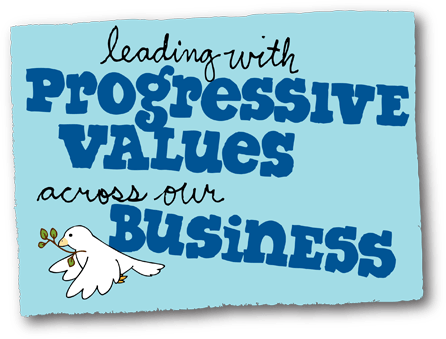
Capitalism and the wealth it produces do not create opportunity for everyone equally. We recognize that the gap between the rich and the poor is wider than at any time since the 1920s. We strive to create economic opportunities for those who have been denied them and to advance new models of economic justice that are sustainable and replicable.
By definition, the manufacturing of products creates waste. We strive to minimize our negative impact on the environment.
The growing of food is overly reliant on the use of toxic chemicals and other methods that are unsustainable. We support sustainable and safe methods of food production that reduce environmental degradation, maintain the productivity of the land over time, and support the economic viability of family farms and rural communities.
We seek and support nonviolent ways to achieve peace and justice. We believe government resources are more productively used in meeting human needs than in building and maintaining weapons systems.
We strive to show a deep respect for human beings inside and outside our company and for the communities in which they live.
Operations
Ben & Jerry’s ice cream for the North American market is made in our manufacturing plants in Waterbury and St. Albans, Vermont and in a Unilever facility in Henderson, Nevada. We also make it for the Canadian market in a Unilever facility in Simcoe, Ontario. Our U.S. frozen novelties are manufactured at a Unilever facility in Sikeston, Missouri. We make Ben & Jerry’s ice cream for the European market in a Unilever facility in Hellendoorn, The Netherlands. Products for Asia and Australia are exported from our facilities in the U.S and the Netherlands.
At the end of 2012, Ben & Jerry’s employed 469 people globally, as compared to 442 in 2011.
VALUES-LED SOURCING
In order to make great ice cream and positive social change, Ben & Jerry’s continues to search for ingredient suppliers all along the supply chain who are aligned with our Company’s mission and core values. These are suppliers who, through their business practices or through their products, are expanding economic opportunities for those not afforded them, leading the way to more sustainable environmental or agricultural practices, or serving the cause of peace and justice. We call this program “Values-Led Sourcing” (VLS).
In 2012 we took some big leaps forward in our commitment to Values-Led Sourcing:
Code of Business Principles
All of the suppliers for Ben & Jerry’s ice cream are expected to follow practices consistent with the Code of Business Principles of our parent company, Unilever. This code includes: continuous improvement in managing environmental impacts, safe and healthy standards for workers, and a firm commitment to human rights, among other things. Unilever is also a signatory to the U.N. Secretary General’s Global Compact of 1999, which commits the company to support and respect human rights within our sphere of influence.
- We harmonized global standards for our Caring Dairy™ program.
- We recalibrated our Fairtrade-certified conversion plan in 2012 so that we could achieve our goal of converting all* of our product line to be Fairtrade-certified. However, due to the size and complexity of this conversion, completing it will take us through 2013 and into 2014. (*No Sugar Added Vanilla Fudge Chip is the only flavor that does not qualify for Fairtrade certification.)
- We pledged to transition to sourcing only non-GMO ingredients for all of our products by the end of 2013, but, just like the Fairtrade conversion, the logistics of this will carry us into 2014 to complete.
CARING DAIRY
Setting Global Standards for Sustainable Dairy Practices –
We’ve been working with dairy farmers in Vermont and the Netherlands for many years to help them push towards the leading edge of sustainable dairy practices. Our Caring Dairy™ program sponsors and supports farmers on their journey of continuous improvement in their social, environmental, and economic performance. The Caring Dairy™ program offers farmers a way to measure and improve 11 sustainability indicators on their farms. We help each farmer develop a unique action plan and provide technical assistance and support to improve his or her practices.
While we have exceeded expectations regarding the number of farmers enrolled in the program in Vermont and the Netherlands, we have not yet implemented Caring Dairy™ with our three smallest suppliers of milk and cream, in North America, serving our factories in Ontario, Canada; Henderson, Nevada; and Sikeston, Missouri. Our intentions are to have all dairy that Ben & Jerry’s sources operating under the Caring Dairy™ program in the future. But right now, our current focus remains on growing Caring Dairy™ in Vermont and the Netherlands, where the majority of our products are made. We believe this so-called ‘mass-balancing approach’ is the most efficient and high-impact way that we can drive improvements in the dairy sector.
The best news for 2012 is that we achieved our goal to fully scale the program in Vermont, so that in combination with our Netherlands program, today Caring Dairy™ farmers produce more than enough of the dairy we need to make our ice cream around the globe!
In addition to scaling the program in Vermont, we took action to unify our efforts to support sustainable dairy practices globally. While our partners in the Netherlands have a long and strong track record of implementing sustainable dairy practices through the Cow Compass and the Dutch version of Caring Dairy™, in 2012 we got our teams together and developed global standards for Caring Dairy™, which we will launch in 2013.
Our long-term goal remains to engage all of our dairy suppliers around the world in sustainable dairy partnerships.
U.S. Highlights
In the U.S., 22 new farmers from the St. Albans Cooperative Creamery, enrolled in the Caring Dairy™ program, bringing the total number of participating farmers in the U.S. to 85. The volume of milk produced by these farms, represents almost 109% of our dairy requirements for 2012, up from 92% in 2011. All of Caring Dairy™ Farmers attended 3 required training sessions, farmers completed over 170 process improvement plans and we saw improved outcomes in 10 of the program’s 11 Key Performance Indicators. We believe the improved scores reflect the effort the farmer’s are making to implement changes on their farm but also realize that external factors such as weather and dairy pricing impact year to year conditions.
Europe Highlights
Our Dutch dairy supplier, CONO Cheesemakers has a long and strong commitment to supporting farmers and ensuring the welfare of their cows. In 2012, 428 farms completed the CONO sponsored Cow Compass, a program that measures and evaluates animal welfare. In 2012 we spent hundreds of hours working with our partners at CONO to craft a global Caring Dairy™ program. We shared best practices and together developed an outcomes-based program, with global standards that supports farmer’s needs and measures performance. At the start of 2013, we expect 100% of the dairy used to produce our products in the Netherlands will come from Cow Compass and Caring Dairy™ farms.
NON-GMO
Advocating for Consumers’ Right to Know About GMO’s –
To be frank, we were not at the top of our game in 2012 when it came to taking a stand on Genetically Modified Organisms (GMO’s) in food products. We are defining genetic modification as the direct manipulation of the organism’s genome using biotechnology. Ben & Jerry’s supports sourcing non-GMO ingredients by origin. Non-GMO by origin refers to non-GMO according to the original seed source. That means that the seeds for ingredients that might use corn or soy, for example, is non-GMO. These ingredients would show up in our chunks and swirls as corn syrup or soy lecithin. Just so you know, our ice cream base mix is already totally non-GMO by origin.
Historically, Ben & Jerry’s has supported a consumer’s right to know. However, in 2012, we did not take a public stand on California’s Prop 37, a ballot proposal to label foods that include GMO’s. We were simply slow to respond to the growing campaign in California on Prop 37 and never weighed in. Not taking a stand goes against our own history regarding recombinant bovine growth hormone (rBGH) and supporting a consumer’s right to know about it. However, we got things back in gear late in 2012 and committed to supporting labeling initiatives that support a consumer’s right to know about GMO’s in their food.
Further, the guidance of our own Progressive Values Statement compels us to source non-GMO ingredients. We are working to achieve this ambition and in 2012 we took a big step and set the goal of transitioning to sourcing only non-GMO ingredients by origin for all of our products and to re-activate our support for a consumer’s right to know through state-by-state legislation or a national framework.
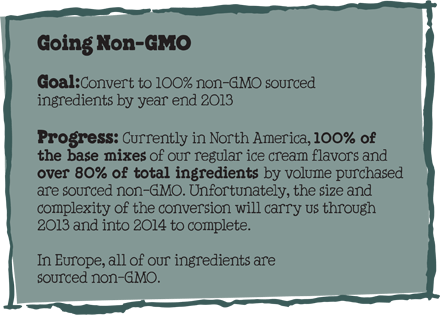
In Europe, where public opposition to GMOs is strong, and where there is legislation that spells out mandatory labeling requirements for foods made from GMOs, it is relatively straightforward to source all ingredients non-GMO. Therefore, all Ben & Jerry’s products made and sold in Europe are sourced non-GMO. Our voluntary labelling commitment applies to the U.S. market only at this time. However, as per the local standards in many countries outside of North America, mandatory labelling is required on products that contain GMO ingredients. While we do not currently make any affirmative “Non-GMO” claims, products made and sold outside North America comply with GMO labelling requirements. We also source non-GMO ingredients for products we sell in Asia where markets require it.
However, in the U.S. and Canada, where mandatory GMO labeling legislation has not been adopted, GMO crops have been fully integrated into the U.S. food supply and it is difficult and expensive to source verifiably non-GMO ingredients. While we’ve been able to secure non GMO sourced ingredients for our base-mixes, which makes up the bulk of our products, our need for conventionally-sourced chunks and swirls from third-party suppliers makes it more challenging to fully source non-GMO ingredients for many of our products.
To measure our progress, we have done a careful analysis of all the chunks and swirls we use in the U.S. and identified all those that are potentially derived from GMOs, such as corn, soy, canola, cottonseed, and sugar beets. This total represents the number of ingredients we still need to convert to non-GMO sourcing. By year-end 2012, over 80% of Ben & Jerry’s was sourced non-GMO by volume of ingredients purchased. We developed a conversion plan that phases in non-GMO sourced ingredients in our chunks and swirls. Our original goal was to complete the conversion by the end of 2013. But, once we got into it, we realized that due to the complexity of the conversion it will take us throughout 2013 and into 2014 to complete.
Further, we are now publicly supporting national and state-by-state efforts in the US to establish GMO labeling laws so that people can know what’s in their food and make their own choices in the marketplace. Early on in this legislative and ballot-item agenda, we came out in support of initiatives in Washington state, Vermont and Connecticut, with an eye on numerous other states considering legislation or ballot items on GMO labeling. We’d prefer a national standard for labeling, but so far, the road to get there appears to be through the individual state efforts.
rBGH
Almost 20 years ago, Ben & Jerry’s came out in opposition to the use of recombinant bovine growth hormone (rBGH), a genetically engineered hormone given to cows to increase their milk production. We think rBGH is a step in the wrong direction towards a chemically-intensive, high-tech food system that has unacceptable social and environmental costs. In the U.S., we require our dairy farmers to pledge that they don’t treat their cows with rBGH, and our products carry a label that states our opposition to rBGH. The U.S. Food and Drug Administration has stated that there is no significant difference between milk from rBGH-treated and untreated cows. But in Canada and most European countries, rBGH has never been able to win government approval, so in those countries, it’s one less thing we have to worry about. Even in the U.S., rBGH use has declined in recent years – and we look forward to the day when it is no longer used in the dairy industry.
As we proceed through our Fair Trade conversion in the next few years, we anticipate this metric will show significant improvement.
FAIRTRADE
In 2010, Ben & Jerry’s pledged to fully convert its global product line to source Fair Trade products by the end of 2013. The decision was an intentional directive to create a meaningful impact for farmers in developing countries around the world. It is the largest and most complex sourcing decision ever made by Ben & Jerry’s.

Admittedly, in 2012 we moved slower than we wanted to, but we did move closer to achieving our goal to fully convert to Fair Trade ingredients throughout our product portfolio. We hit some speed bumps when we made the decision to completely align our Fair Trade efforts in the US and around the world with Fairtrade International. This fully-global partnership required us to pause, recalibrate our conversion plan in the US as Fairtrade International re-established its licensing initiative in the US following Fair Trade USA’s departure from Fairtrade International at the end of 2011. Our conversion includes over 100 ingredients in 200 different products. The logistics behind that scale of conversion can slow down any ambition. Ben & Jerry’s Fairtrade conversion will now require the balance of 2013 and part of 2014 to complete. We have some strong headwinds, but we are leaning in.
Our plan is to first convert our five key commodities: sugar, cocoa, vanilla, banana and coffee, throughout our base mixes and then in all of our chunks and swirls in all of our products. By accomplishing that, we will achieve Fairtrade certification for all of our products. There will be a few remaining ingredients, such as certain fruits, nuts and spices that we are unable to source from Fair Trade suppliers. In those cases, Fairtrade International has provided us derogations (approved waivers) to show that despite our efforts to source these products from Fair Trade suppliers, we were unable to either because they did not meet our specifications or were just not available. In those cases we will co-create with Fairtrade International a Producer Development Fund to design projects that will help Fairtrade producers improve on quality, capacity and reliability for their products. We will continue to work with Fairtrade International and Fair Trade suppliers to try to source these products as they become available.
Overall, the Fair Trade conversion process has been complicated and at times daunting, but it is a challenge we fully embrace. We will stay vigilant to ensure the Fair Trade model makes a true impact to fulfill the farmers’ needs, and best achieve the social, economic and environmental promise of the Fair Trade model.
Learn more about Fair Trade in the US or around the world.
Building the Fair Trade Movement
Fair Trade will only succeed in its mission to create social, economic, and environmental benefits in developing countries if ice cream-lovers and coffee-drinkers and morning banana-eaters understand what Fair Trade is – and seek out products with the Fair Trade logo. That’s why we think teaching people about Fair Trade is just as important as sourcing Fair Trade ingredients for our products. We want to work at both ends of the Fair Trade system: educating consumers to create more demand, and working with Fair Trade stakeholders within the system to improve supply and livelihoods for Fair Trade producers.
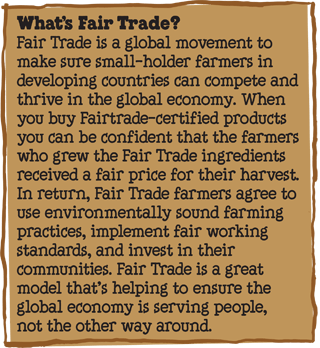
In 2012 we kept up efforts to educate consumers about the value of Fairtrade-certified and strengthen the Fair Trade system. Here’s how:
- We convened with leading Fair Trade stakeholders at a two day summit in 2012 to redefine and re-energize the Fair Trade movement in North America.
- We continued to contribute proceeds from our flavor, “Late Night Snack” to support Fair Trade Universities in the US.
- We participated in events for World Fair Trade Day, Fairtrade Fortnight in the UK, and Fair Trade Month in the U.S. to spread the word!
- And several of Ben & Jerry’s scoop shops have supported their local communities’ efforts to become Fair Trade towns.
Converting Our 5 Key Commodities to Fairtrade-Certified
SUGAR: Our goal is to make sure that the sugar we use in our products is coming from suppliers who are doing right by their workers and following environmentally friendly and sustainable farming practices.
In Europe, we have been phasing in Fairtrade sugar in all Ben & Jerry’s products since 2010 and in 2012, 99.8% of sugar used in our based mix in Europe was Fairtrade-certified. In North America, we continue to struggle in 2012 to secure fair trade sugar that is suitable for use in our products. We are working with others in the Fair Trade movement to develop this supply in time to meet our goal of converting to Fairtrade sugar by year end 2013.
GOAL: 100% conversion to Fairtrade sugar in our base-mix, globally, by the end of 2013.
PROGRESS: In 2012, globally, Fairtrade sugar represented 29.4% of sugar used in our base mix. Up from 23.1% in 2011.
In North America, in 2012, just .2% of the sugar used in our base mix was Fairtrade. In 2011 100% of the sugar used in our base mix was conventional.
In Europe, in 2012, 99.8% of the sugar we added to our base mix was Fairtrade. In 2011, 74.9% of sugar used in our base mix was Fairtrade.
COCOA: For many die-hard Ben & Jerry’s fans, there wouldn’t be much point to eating ice cream at all if it didn’t have chocolate in it somewhere. So it’s no surprise that nearly three-quarters of our flavors have chocolate or cocoa in them, in the form of cocoa powder, chocolate chunks, milk chocolate Peace signs, fudge swirls, and various other gobs, chips, and flakes
Taken together, these ingredients use a significant volume of cocoa powder or cocoa butter. We believe that by transitioning these cocoa-based ingredients to Fair Trade Certified, we can have a significant impact on improving the livelihoods of our cocoa farmers.
GOAL: Our goal is to transition to 100% Fairtrade-certified cocoa powder and to work with Values-Led suppliers for other chocolate ingredients [link to Chunks and Swirls] by the end of 2013.
PROGRESS: In 2012, Fair Trade cocoa represented 92.8% of global cocoa powder, up from 76.3% in 2011.
In North America, the purchase of Fair Trade cocoa increased from 58% in 2011 to 88.2% in 2012.
In Europe we held steady at 100%.
VANILLA & COFFEE: Natural flavorings such as vanilla and coffee extract are an important part of the party inside our pints. We are transitioning these ingredients to Fairtrade-certified. While we still have some work to do in North America, our European-based ice cream makers have reached the target and are using 100% Fairtrade coffee and vanilla flavorings.
GOAL: Our goal is to use 100% Fairtrade-certified coffee extract and vanilla in all our products by the end of 2013.
PROGRESS: We are pleased to report that we are well on our way to our goal of 100% Fair Trade Certified coffee in all our products. In 2012, 99% of the coffee used in our global production was Fair Trade Certified, up slightly (about a half of a percent) from 2011.
We saw a similar increase in North America where we went from 99.2% in 2011 to 99.7%.
In Europe in 2011, 100% of coffee used in production was Fair Trade Certified. However, in 2012 we didn’t use any Fair Trade Coffee, but that’s because we did not manufacture any products in Europe with coffee ingredients.
Globally in 2011 66.5% of all vanilla used was Fair Trade Certified. In 2012 we increased the amount of Fair Trade vanilla to 90.7%.
In North America we are moving forward on the path to Fair Trade vanilla moving from 79% in 2011 to 88.2% in 2012.
In 2012 100% of the vanilla purchased in Europe was Fair Trade Certified.
BANANAS: We have high standards for the fruit we use in our ice cream. Beyond excellent quality, we want them to be grown, harvested, and processed in ways consistent with our values. For some ingredients, that means we are moving towards Fair Trade certification. We also have a goal to source some of our fruit from suppliers who meet our ‘Values-Led Sourcing” (VLS) criteria, meaning they are delivering extraordinary social or economic benefits through their products, their business operations, or their business model. As fruit is a relatively small part of our total ingredient purchases, it has been a lower priority for developing Fair Trade and VLS initiatives.
In an effort to make some headway converting fruit to Fairtrade-certified or VLS, in 2012, we decided to focus our efforts on the one fruit that makes up a major portion of all the fruit we purchase, bananas.
GOAL: Our goal is to use 100% Fairtrade-certified banana puree in all our products by the end of 2013.
PROGRESS: The good news is that in Europe 100% of bananas purchased have been Fair Trade Certified since the end of 2011. The not so good news is that in North American we continue to rely on 100% conventional bananas. The worst news, at least statistically speaking, is that because the volume of conventional bananas used in North America increased (thanks to Banana Peanut Butter Greek Yogurt), our global percentage dropped from 28.2% in 2011 to 18.8% in 2012.
However, to leave you on a good note, we are on track to fully convert North American production to Fairtrade-certified bananas by the end of 2013. Whew!
CHUNKS & SWIRLS: The number of different chunks and swirls in Ben & Jerry’s ice cream literally reaches into the hundreds, from plain walnuts to chocolate-covered waffle cones to whiskey-caramel swirls.
GOAL: Fully convert the five key commodities in our chunks and swirls to Fairtrade-certified ingredients by the end of 2013.
PROGRESS: The good news is that in Europe 100% of bananas purchased have been Fair Trade Certified since the end of 2011. The not so good news is that in North American we continue to rely on 100% conventional bananas. The worst news, at least statistically speaking, is that because the volume of conventional bananas used in North America increased (thanks to Banana Peanut Butter Greek Yogurt), our global percentage dropped from 28.2% in 2011 to 18.8% in 2012.
However, to leave you on a good note, we are on track to fully convert North American production to Fairtrade-certified bananas by the end of 2013. Whew!
Values Led Suppliers
We started a process in 2012 of reviewing our Values-led Sourcing (VLS) program and what it means to be a VLS supplier to Ben & Jerry’s. In 2013 our goal is to more clearly define our VLS criteria and apply it to all of our suppliers, across the board. Eventually, we want all of our suppliers to play increasingly significant roles in creating social, economic and environmental benefits. Currently, under our historical standards, three suppliers are considered VLS partners:
- The Greyston Bakery in Yonkers, New York, has been supplying us with chocolate brownies for our Chocolate Fudge Brownie flavor for over 20 years. The bakery is owned by the Greyston Foundation, a nonprofit organization with a mission to support low-income people and families on the path to self-sufficiency. Greyston’s programs reach over 2,000 people a year through child care, housing, health care, and other services! Our relationship with Greyston is really a win-win.
- Rhino Foods is another longtime supplier that makes the gobs of cookie dough we use in our Chocolate Chip Cookie Dough ice cream. Rhino has, over time, developed a variety of programs that supports its employees and the surrounding community. Rhino employs dozens of people who have come to the U.S. as refugees from around the world. Through a unique variety of support programs, Rhino helps these and all of its employees to earn a living, save money, develop a credit history, and make a new life for themselves and their families.
The Superior Nut Company also supplies Ben & Jerry’s with some of our peanut-based inclusions. Superior Nut has invested for many years in a leading reforestation project in Costa Rica that aims to offset the company’s carbon emissions.
EGGS
Cage-free & Free-range Eggs
Several years ago, Ben & Jerry’s decided to switch to using certified-humane cage-free eggs in our ice cream. We were convinced by the research that cage-free egg systems, combined with rigorous third-party certification, allow hens more opportunity to engage in normal hen behaviors such as roosting, scratching, and stretching their wings.
As one of the first companies to commit to certified-humane cage-free, we were ahead of the market and had to make the change in stages so the cage-free egg industry could catch up with our demand. We also had logistical challenges of our own to solve. We went ‘free-range’ for our European egg supply starting in 2005; and we started the transition to cage-free in the U.S. in 2007.
At the end of 2012 we were well on our way to completing the conversion with 97.5% of the eggs used in North America cage-free. The percentage of cage-free eggs used to make our products in North America decreased slightly from 2011 to 2012 from 98% to 97.5%. This slight decrease in North America was due to production at Sikeston (bars) and Simcoe and Henderson where on a few occasions, due to inventory issues, conventional eggs instead of cage-free were used. We’re making sure that doesn’t happen again!
GOAL: Source 100% certified-humane cage-free eggs in North American production and 100% free range in European production.
PROGRESS: 97.5% reached in North America; 100% reached in Europe.
Sugared Eggs
Beyond the cage-free egg transition, we are also working to make sure that the eggs we buy are sweetened with Fairtrade sugar.
GOAL: 100% Fairtrade sugared eggs by end of 2013.
PROGRESS: In 2012, in the US .2% of sugared eggs were Fairtrade, up from 0% in 2011.
In Europe, we made significant progress and in 2012 100% of the eggs we used in our ice cream were processed with Fairtrade sugar, up from just 61.9% the previous year.
On a global basis, therefore, we estimate that in 2012, 37% of sugared eggs used in our ice cream were Fairtrade-certified.
MINORITY SOURCING
It is our intention to develop a metric that measures the volume of Ben & Jerry’s sourcing that comes from women-owned or minority-owned suppliers. At this time, a clearly defined minority sourcing program is not in place and no data is collected that focuses specifically on this area. We will develop the metrics to measure our progress in this area once we have begun to develop a program.
COMMUNITY INVOLVEMENT & ACTIVISM
Social Mission Activism
It’s a good for us to turn a shovel, lift a hammer or dip a paint brush to do some good in our local communities, but Ben & Jerry’s involvement in the community goes well beyond that. It extends to activist campaigns around important issues that are aligned with our Company values and partnerships with organizations that share our values and view of the world. We’ve never been afraid to speak up for social and economic justice, sustainable food, or peace! Here’s a look at where we were active in 2012.
Supporting a Fair and Just Political System
Ben & Jerry’s has been advocating for democracy and justice since the first cone was scooped in 1978. Over the years we have taken an activist stand and provided support to citizens’ efforts to rein in corporate money in politics, we pay a livable wage to our employees, we directly support family farms and we are working to source fairly traded ingredients for all our products.
Inspired by the Occupy movement, in 2012 we launched the Get the Dough Out of Politics campaign to increase awareness of the need for fundamental reforms that will reduce or eliminate undue corporate influence in the democratic process and to encourage citizens to take a stand. We re-launched the Stephen Colbert approved flavor, AmeriCone Dream with new packaging featuring the Get the Dough Out message, kicked off a mobile grassroots effort across the country, launched a social media campaign to encourage citizens to sign a petition that calls for Congress to pass a constitutional amendment that overturns Citizens United and on Valentine’s Day, we gave away a ton of free AmeriCone Dream at our scoop shops throughout the country.
In addition to the Get the Dough Out campaign, in 2012, Ben & Jerry’s helped support Business for Democracy, a campaign to raise the voice of business leaders who are concerned about the corrupting influence of corporate money in American politics. In 2011, on the first anniversary of the U.S. Supreme Court’s Citizens United decision (which gave corporations the green light to spend unlimited money to influence election outcomes) our co-founders, Ben Cohen and Jerry Greenfield, joined with dozens of other business leaders to sign a statement in support of a Constitutional amendment to overturn Citizens United. Since then, Business for Democracy has grown to include over 2,400 business leaders nationwide.
While we acknowledge that we have our work cut out for us, we are committed to do what we can to keep corporate money out of our elections.
Ben & Jerry’s was invited to provide testimony to the Senate Subcommittee on the Constitution, Human Rights, and Civil Rights in July 2012 because of our efforts in the Get the Dough Out of Politics campaign. fFnd out what our CEO had to say to the US Senate Subcommittee.
Advocating for Animal Welfare in Europe

In 2012, The Ben & Jerry’s European team joined forces with animal welfare organizations to advocate for the Supporting Better Dairy campaign, calling for a European Directive on dairy cow welfare. The campaign calls for improved and humane conditions for cows throughout Europe, including:
- Good Housing: Access to grazing and standards for indoor housing
- Good Feeding: Daily diet that meets the cow’s needs
- Good Health: Ensuring cows are healthy, and do not undergo pain and suffering
- Appropriate Behavior: Cows have the opportunity to express their natural behavior.
While EU regulations already safeguard other farm animals, dairy cows currently have no such protection. This means their welfare standards vary greatly across the EU, with some suffering from inadequate housing, lack of access to pasture, meager diets and poor health.
Supporting Better Dairy aimed to run the first-ever animal welfare European Citizens’ Initiative (ECI), allowing EU citizens to propose new legislation for improving standards for Europe’s 23 million dairy cows. The campaign hopes to raise the bar by introducing basic standard EU-wide legislation through the ECI, at a time when there is more consumer interest in dairy cow welfare than ever before.
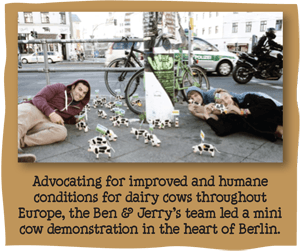 Supporting Better Dairy aimed to run the first-ever animal welfare European Citizens’ Initiative (ECI), allowing EU citizens to propose new legislation for improving standards for Europe’s 23 million dairy cows. The campaign hopes to raise the bar by introducing basic standard EU-wide legislation through the ECI, at a time when there is more consumer interest in dairy cow welfare than ever before.
Supporting Better Dairy aimed to run the first-ever animal welfare European Citizens’ Initiative (ECI), allowing EU citizens to propose new legislation for improving standards for Europe’s 23 million dairy cows. The campaign hopes to raise the bar by introducing basic standard EU-wide legislation through the ECI, at a time when there is more consumer interest in dairy cow welfare than ever before.
While the campaign was gaining momentum, by the end of 2012, due to functional issues around the ECI tool, in collaboration with our partners, we decided to drop the ECI and focus on encouraging citizens to sign up to the campaign directly. We continue to work with our partners to raise awareness and by urging European decision makers to improve welfare for the EU’s dairy cows. We plan to collect more signatures into 2013 and deliver them to EU Parliamentarians. We are hopeful Parliament will take action for the cows in 2013, until that happens we’ll continue to advocate for their welfare and happiness.
Standing for Marriage Equality & Apple-y Ever After
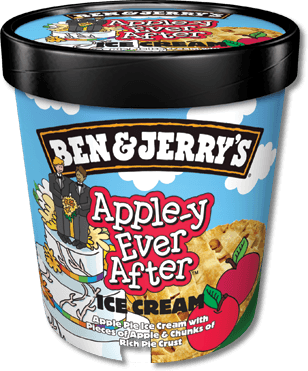
Ben & Jerry’s has a long history of commitment to social justice, including gay rights. This commitment is grounded in our Company’s core values, which include a deep respect for people inside and outside our Company and an unshakable belief that all people deserve full and equal civil rights. Until same sex couples are afforded the same rights as heterosexual couples, we will continue to work with relevant nonprofit partners to build public support for marriage equality, add our voice to the public discourse around marriage equality and celebrate the expansion of marriage equality to new states and countries.
In 2012, when the issue of marriage equality heated up in the UK, we jumped on board to show our support and help raise awareness by renaming our Apple Pie flavor Apple-y Ever After. In partnership with Stonewall, the UK-based gay rights organization, we launched a website and social media campaign to stir up the discussion and help convince members of Parliament to pass legislation supporting same-sex marriage. Although we think the tides are turning, at the end of 2012, Parliament had yet to pass legislation for marriage equality. This is an issue close to our core and we’ll continue to advocate for and help raise awareness of the issue of marriage equality for as long as necessary.
To learn more about Ben & Jerry’s position on marriage equality and gay and lesbian rights, click here.
Apple-y Ever After is the second Ben & Jerry’s flavor named in support of same-sex-marriage. In 2009, we lobbied legislators in our home state of Vermont to support a bill allowing same-sex marriage – and we shared our excitement when the new law took effect by unveiling the flavor Hubby Hubby – actually a symbolic renaming of our iconic flavor, Chubby Hubby, for one day.
Supporting Young Social Entrepreneurs
In 2012, in partnership with our friends at Ashoka we launched the Join Our Core competition to find and help support the best young social entrepreneurs across Europe. From a pool of nearly 200 applicants 15 were selected as finalists. These 15 went to Uganda for the competition’s final leg: a week-long set of tasks living and working with Fair Trade vanilla farmers and a group of local aspiring entrepreneurs, in partnership with international development charity VSO.
One winner was then chosen from each of the five competing countries: the UK, Ireland, Sweden, Denmark and the Netherlands. The Five winners each received a €10,000 cash prize and a business mentoring program from the social enterprise gurus at Ashoka. The winners will also have their names featured on Clever Cookies, a new commemorative Ben & Jerry’s flavor in 2013.
Overall, Join Our Core was a smashing success, a ton of fun and a perfect way for Ben & Jerry’s to support young entrepreneurs who share our vision of linked prosperity. We can hardly wait to do it again in 2013.
Read more about the Join Our Core finalist on the Join our Core website.
Scoop Shop Social Action
Ben & Jerry’s began as a single ice cream scoop shop in 1978, and though our business has expanded wildly since then, our roots are still firmly planted as a scoop shop company. Most are owned and operated by independent franchisees, although Ben & Jerry’s also operates three company-owned stores. A handful of our scoop shops are what we call a PartnerShop®.
In many ways, our scoop shops are the centerpiece of our Social Mission, because they are the places where we directly touch local communities. Every year, they contribute hundreds of thousands of dollars in time, ice cream, and sponsorships in support of community projects of all sizes and shapes, from Green-Up Days to Food Drives to Hunger Walks. On Free Cone Day, many of our franchisees team up with local charities to raise awareness and money from free ice cream seekers who flock to their shops by the thousands. Once a year, the franchise community gets together for a community service project in conjunction with their franchise community meeting. In 2012, more than 200 franchisees, managers, staff and friends rolled up their sleeves to help revitalize a primary school and a rundown park in the Bahamas, where the meeting was held.
Franchise Community Global Gathering Service Project
Our largest company supported community project happens annually in conjunction with our Global Franchise Gathering. In 2012, nearly 200 franchisees, staff and friends braved the hot Caribbean sun to clean-up Father Marshall Cooper Park, a popular but run-down commons, and the Woodcock Primary School, a public institution that serves over 400 children which previously had no playground equipment. Click here to see Photos.
Measuring Social Impact Among Franchisees
Although we are still perfecting the way we assess it, we do our best to try to measure the Social Mission engagement of our franchisees - and our support for their Social Mission activities. To do this, we look at several specific scores that relate to financial performance; the franchisor-franchisee relationship; and Social Mission activities. Most of this data is proprietary or, because it relates to our business relationships with franchisees, is too sensitive to report publicly. At this time, we are only able to measure Social Mission engagement in our U.S. scoop shops.
Here’s what we can tell you. In general terms we saw improvements in 2012 on 3 of the 4 measures of scoop shop financial performance, relative to 2011. Likewise, we saw improvements in 3 of the 4 measures of the franchisor-franchisee relationship and 5 of the 6 measures of Social Mission engagement improved.
Scoop Shop Community Action Program (CAP)
In 2012 we decided to put our money where our heart is and piloted the Scoop Shop Community Action Program (aka CAP Grant Program) to support franchisee’s efforts to get involved in their communities and give back. We worked closely with 14 scoop shops to help them mobilize their CAP’s and provided some financial support to help the projects happen. We are encouraged by the 14 shops that participated in the pilot and we are thrilled about scaling up the program in 2013.
Employee Community Action Team (CAT) Projects
The Ben & Jerry’s Foundation funds the Vermont Community Action Team (CAT) grant program, which was created to allow Ben & Jerry’s employees to support organizations in the places where they live and work. Each site gives away $60,000 for the year and has a CAT that consists of 8-12 members. The CATs meet monthly and make grants between $500 - $2,000. The CAT’s focus their decisions based on these guidelines: underserved populations including seniors; at-risk youth; low-income people; needs of underserved communities; basic human needs; and organizations that are primarily volunteer-led. In 2012, The CAT’s made grants totaling $180,500 to 152 organizations. Here are a few examples of the Community Action Team grants that were made:
With a grant of $500, The Waterbury CAT helped the Barre Area Senior Center create a computer lab and resource center for elders to learn computer basics, email friends & family and community activities.
The Central Support CAT made a $1000 grant to Camp Exclamation Point, Inc. (CAMP!) a one-week residential summer program for over 100 Vermont children from migrant families who work seasonal jobs in the agriculture, dairy or timber industries and have limited opportunities.
The St. Albans CAT, with a grant of $600, helped support Fairfield Farmers Market Online to give the community access to high quality, healthy food being grown and prepared by local farmers. Buying food locally encourages investment in the community, supports the local economy, increases the established network of producers in the area and provides access to good food despite economic hardship.
In addition to individual grants, each year, Ben & Jerry’s employees work together on several large-scale community service projects that the CATs organize - to fix, clean, build, and refresh things that improve the quality of life for our communities:
- St. Albans successful CAT events: 2012 summer Call to Camp projects at Camps Abenaki, Hochelega, and TaKumta, which serves kids dealing with cancer
- Waterbury 2012 CAT events: Little River State Park, 22nd Annual Pumpkin Giveaway, Waterbury “Not Quite So Independence Day”
- July 19, 2012 – Waterbury manufacturing brought the last 3 pallets of relief aide being stored in the Waterbury plant warehouse to the local food shelf for Irene storm recovery.
- May 24, 2012 - Central Support Site project: clean-up, fix-up, at Camp DREAM in Fletcher, Vermont.
Nonprofit Partnerships
We are honored to have the opportunity to partner with some truly amazing nonprofit organizations, all around the globe. We support these partners in a variety of ways including product and cash donations, royalties from flavors, volunteer hours, purchasing their products, investing in their enterprises and collaborating to move social issues we care about forward. While we hope their affiliation with us offers our partners some real benefit, our connections to these NGOs keep us true to our core and inspire us every day.
Starting with our perennial and primary partnership with the Ben & Jerry’s Foundation, here are a few of the organizations we partnered with in 2012:
The Ben & Jerry’s Foundation
Part of Ben & Jerry’s commitment to social and economic justice is our support of the Ben & Jerry’s Foundation, which makes grants to grassroots activists making positive change in their own communities. Through the Foundation, we’re helping immigrant workers, neighborhood groups, farm workers and dozens of other groups around the country to get organized and fight for a fair deal. Grant decisions are driven by a non-management level employee committee who reviews proposals and makes funding recommendations.
In 2012, Ben & Jerry’s contributed $2,231,804 to the Foundation based on the 2011 sales of the Company.
To learn more about The Foundation and the organizations they support, visit their website.
Ashoka & VSO
In 2012 we partnered with the social entrepreneur guru's at Ashoka and the UK-based anti-poverty charity VSO - our partners for Join Our Core. With their help, Join Our Core, a competition to find the most innovative young social entrepreneurs across Europe, was a huge success. We can't wait to do it all over again in 2013. Click here to learn more about Ashoka, VSO and Join Our Core.
Mission Australia
Mission Australia works with us in Australia to help provide jobs and job training in our scoop shops, for disadvantaged young people. Learn more about Mission Australia.
DREAM Partnership
DREAM, is a nonprofit mentoring organization that matches college mentors with young people growing up in subsidized housing projects. Within our South Burlington office, Ben & Jerry’s donates office space to DREAM. DREAM staff have access to shared resources in the building, including the employee kitchen, meeting rooms, and photocopiers. We’re glad to be able to support its innovative and important work.
The Peace Alliance
In 2012, we supported The Peace Alliance in advocating for the Youth PROMISE Act, legislation in the US to support much needed, community-driven prevention and intervention programs to keep kids drug-free and safe.
PartnerShop™ Partnerships
PartnerShops are Ben & Jerry’s Scoop Shops that are independently owned and operated by community-based nonprofit organizations. Ben & Jerry’s waives the standard franchise fees and provides additional support to help nonprofits operate strong businesses.
PartnerShops offer job and entrepreneurial training to youth and young adults that may face barriers to employment. Ultimately, they help people build better lives.
Learn more about the nonprofits that operate our PartnerShops.
Royalties Paid to Nonprofits
Every day around the globe, in scoop shops, shopping centers, and grocery stores, a percentage of sales of certain Ben & Jerry’s products are directed to nonprofit charitable organizations, including Fairtrade organizations. These products include:
- All Fairtrade-certified flavors sold in Europe and Fairtrade-certified flavors sold in the U.S. contribute licensing fees that support the work of Fairtrade labeling organizations and around the world – in addition to Fairtrade premiums paid to farmers or farmer cooperatives for the ingredients they grow for us.
- Phish Food® (global) – Some of the royalties from this flavor are paid to the Waterwheel Foundation’s Lake Champlain Initiative, which protects the health of this beautiful lake on Vermont’s western border, and its surrounding watershed.
- Stephen Colbert’s AmeriCone Dream™ (US) – Royalties are paid to the Stephen Colbert AmeriCone Dream Fund and its mission to benefit children, veterans, and the environment.
- Jimmy Fallon’s Late Night Snack – Royalties benefit Fair Trade Universities
- Bonnaroo Buzz – Bonnaroo Works Fund
- Dave Matthews Band’s Magic Brownies® (US) – Royalties go to Bama Works, a nonprofit organization that supports charitable programs in the Charlottesville, Virginia area including those serving disadvantaged youth, the disabled, protection of the environment, and the arts and humanities.
- Willie Nelson’s Country Peach Cobbler™ (US) – Royalties are paid to Farm Aid and its ongoing mission to support family-farm centered agriculture in America and to keep family farmers on their land.
B Corp Certification
Ben & Jerry’s has always believed in linked prosperity - that all stakeholders connected to the business should prosper as it prospers, from those who produce the ingredients, to employees who make the product, to the communities in which the company operates.
A quarter-century after pioneering the socially responsible business movement, Ben & Jerry’s is happy to announce that in 2012 we became the first wholly-owned subsidiary to gain B Corp Certification. B Corps are a new type of corporation which use the power of business to solve social and environmental problems. B Corps must satisfy a rigorous assessment by the non-profit B Lab that covers: corporate governance, worker benefits, community engagement and environmental performance. Ben & Jerry’s scored 89 points, above the minimum 80 points to achieve B Corp certification. We are planning to update our assessment in 2013 with the expectations to raise our score.
B Corp Certification is the next chapter for socially responsible businesses. Unilever fully supports Ben & Jerry’s B Corp Certification.
Learn more about B Corporations and view Ben & Jerry’s Impact Assessment at: www.bcorporation.net/community/ben-jerrys
LIVABLE WAGE & MORE
Employee Wellbeing & Culture
Livable Wage
Ben & Jerry’s is committed to paying all of its full-time manufacturing workers a livable wage. In 1995 we established a method for calculating a livable wage benchmark for Vermont. We defined it as the starting wage for a single person that will sustain a reasonable quality of life to include expenditures for housing, utilities, out-of-pocket health care, transportation, food, recreation, savings, taxes, and miscellaneous expenses. Since then, we’ve adjusted this livable wage annually to ensure the relative value is sustained in today’s marketplace.
Ben & Jerry’s livable wage benchmark for 2012 was $15.97 per hour, up from $15.34 per hour in 2011 and from $14.64 in 2010. This hourly wage translates to $33,218 per year. For comparison, at year-end 2012, the minimum wage in Vermont was $8.46/hr ($17,600/yr) and the national minimum wage was $7.25/hr ($15,080/yr).
Diversity
Ben & Jerry’s is an equal opportunity employer that values diversity in our workforce. One element of this commitment is our application of Affirmative Action practices to look for conspicuous imbalances in our workforce and take positive steps to correct them. Affirmative Action plans focus on equality in hiring, training, promoting, and compensating employees. There were no areas in which statistically significant adverse impact to our employees were found.
Volunteer Benefit
Each year, through a variety of Company sponsored volunteer hours, we encourage our employees to get out into the real world and give back. That can come in the form of 40 paid volunteer hours that many of our employees can use, or group projects that are organized by Ben & Jerry’s worksites or at various Company gatherings throughout the year. Overall, adding up group community projects and individual volunteer time, we estimate that employees logged 3,552 hours of paid volunteer time in 2012, which was down a few hours from the 3,563 that we logged in 2011. But the truth is that we don’t believe we are properly capturing all of the volunteer hours people are using, which are self managed and reported. So, we need to do a better job of that.
CLIMATE & ENVIRONMENT
For Ben & Jerry’s, the issue of climate change is not just an environmental issue; it is an issue of social and economic justice -- Climate justice, if you will. The rich, developed countries of the north are responsible for the overwhelming majority of CO2 emissions in the atmosphere that are driving global warming. And it is the least developed and poorest countries of the south that will suffer the worst impacts and are least able to afford to adapt. Our business is at the center of some of the most pressing climate issues: we rely on agriculture for our main ingredients; manufacturing to make our products; trucks to transport our finished products; and freezers to store our products. We are working throughout our operations to reduce the impact of our footprint.
For many years, we have invested aggressively in energy-efficient technology from cooling systems to lighting to water and waste management systems at our manufacturing plants. We continue to devise and pursue innovative plans to reduce the greenhouse gas emissions associated with our business to respond to the urgent challenge of climate change. We send dairy waste from our Vermont ice cream plants back to two of the farms that supply us with fresh dairy ingredients. Our waste is put into methane digesters with other farm waste - where it generates energy to power the farm!
Manufacturing
One of the many highlights for us in 2012, was when Environmental Protection Agency Administrator Lisa Jackson, visited our Waterbury manufacturing site and was impressed with the level of environmental actions there including the water reuse and conservation program.
Nonetheless, in alignment with our values, Ben & Jerry’s is in the process of transitioning away from GMO ingredients in our U.S. and Canadian products.
Ben & Jerry’s ice cream for the North American market is made in our manufacturing plants in Waterbury and St. Albans, Vermont and in a Unilever facility in Henderson, Nevada. We make Ben & Jerry’s ice cream for the European market in a Unilever facility in Hellendoorn, The Netherlands and for the Canadian market in a Unilever facility in Simcoe, Ontario. We make ice cream for Asian markets in our Vermont manufacturing plants. Our frozen novelties are manufactured at a Unilever facility in Sikeston, Missouri. We recognize the impact that our manufacturing process has on the environment and work at all levels to reduce our environmental impact.
We are measuring Ben & Jerry’s environmental impact for the purposes of our QoR metric by looking at four performance parameters at every plant that makes Ben & Jerry’s ice cream products - water, solid waste, energy and CO2 emissions. Using a formula that weights each plant’s performance by the volume of Ben & Jerry’s products it produces, we calculated the following outcomes in 2011: (weighted global results - normalized performance – per gallon of product).
2012 EPR Numbers
- Water Use: 2.7 % better than 2011 (cubic meters per unit of production)
- Solid Waste: 11.9 % worse than 2011 (kg per unit of production)
- Energy Use: 1.2 % better than 2011 (gigajoules per unit of production)
- CO2 Emissions: 60.5 % better than 2011 (kg per unit of production)* *Significant improvement likely due to purchase of RECs (Henderson, Sikeston North, & Sikeston South) in 2012 to offset C02 associated with electricity use in the EPR.
In 2012, Ben & Jerry’s U.S. business scored 81 out of 100 in its climate impacts ranking by the independent nonprofit Climate Counts, up from 71 in 2010. This put Ben & Jerry’s near the top of the climate rankings for food manufacturing companies in the U.S. We did not complete a 2012 Climate Counts scoring for European business.
Carbon Reduction and Offsets
For the 13th year, we offset all of the emissions associated with our Vermont manufacturing facilities and employee air travel with the help of Vermont-based NativeEnergy, a nationally recognized provider of high quality carbon offsets. All of our U.S. offsets support the development of new sources of renewable energy.
Part of the plan for climate mitigation in Europe included the installation of a bio-digester at our manufacturing plant in Hellendoorn, the Netherlands, which turns the factory’s dairy waste into energy. For Hellendoorn, in 2012:
- The power is coming from certified CO2 neutral sources.
- A bio-digester was installed and is running, which is fed with waste water and ice cream waste. We are still improving and redesigning it to improve its performance. Biogas is produced.
- We have built a totally new heat conversion plant, where we burn the biogas. This installation is now commissioning and soon, in practice, we would need no natural gas anymore. The site would then be CO2 neutral
- A planned bio-filtration system (a living machine) was cancelled for now. Waste water is not clean enough yet. We will re-evaluate this viability of this project and determine whether to continue with it.
Packaging
For years, Ben & Jerry’s has been working to reduce the negative environmental impacts of our packaging materials. It has always been a challenge, given that our packaging must meet strict requirements for food packaging and also has to stand up to temperatures of 20 degrees below zero (F).
Pint Cartons and Novelty Boxes
In recent years, we have focused on making sure all of the paperboard used in our pint cartons and novelty boxes (our two largest packaging uses) is coming from environmentally friendly sources. Toward this end, we have phased in Forest Stewardship Council (FSC) certified paperboard for all of our U.S. pint containers. The FSC certification means that the paperboard comes from forests that are managed for the protection of wildlife habitat, maintenance of biodiversity, avoidance of genetically modified tree species, and protection of traditional and civil rights, among other Rainforest Alliance criteria for healthy forests.
Our plan to convert our primary European packaging to FSC-certified in 2012 was successful. That helped us improve significantly in this area. In 2012, on a global basis, we estimate that 96% of the paperboard we used in our primary packaging was FSC certified, up from 61% in 2011, measured by weight.
While our pint containers are not allowed to contain post-consumer recycled material because of food contact regulations, we are using 100% recycled paperboard in the boxes that we use for Ben & Jerry’s ice cream bars in the U.S.
We are confident that we can continue to improve our primary packaging materials, such as pints and 500 ml tubs, in the years ahead. Our long-term goals include using unbleached paperboard and finding food-safe renewable resins that can make our packaging fully compostable.
Scoop Shops
On an ongoing basis, we are working to improve the materials used in Ben & Jerry’s scoop shops, such as bowls, spoons, drink cups, napkins. For example, in the U.S., we have used unbleached paper in our napkins for many years and our drink cups, while made of plastic, are recyclable and have been light-weighted to use as little material as possible.
Corporate Office Materials
In our corporate office, we have made significant strides in using environmentally friendly materials, including 100% post-consumer recycled and process chlorine-free paper; compostable dinnerware, green cleaning solutions, low-VOC paints, and flooring that is recyclable.
Note: We have not yet developed metrics that track our progress towards improving the environmental attributes of our secondary packaging, scoop shop packaging or our office materials. We will keep working on it!
Greener Freezers
In 2011, when we got the green light from the U.S. Environmental Protection Agency (EPA) to use hydrocarbon (HC) freezers in the U.S., we launched a pilot test with 250 of these next-generation freezers. The success of the pilot cleared the path and in 2012, we rolled out an additional 840 HC freezers in our supply chain for a total of 1,090 cabinets in operation.
Supporting Stronger Climate Policy
In 2012, we re-energized our commitment to our membership in BICEP, or, spelled out, Business for Innovative Climate and Energy Policy.
BICEP is an advocacy coalition of businesses committed to working with policy makers to pass meaningful energy and climate legislation that will enable a rapid transition to a low-carbon, 21st century economy that will create new jobs and stimulate economic growth while stabilizing our planet’s fragile climate.
As a member of the coalition, in 2012, we supported several campaigns encouraging Congressional leaders to make legislative decisions supportive of clean energy policies and to focus on the vital task of passing comprehensive energy and climate legislation.
BICEP’s work in 2012 was refocused to smaller more focused policies because of a lack of movement on a comprehensive approach. Ben & Jerry’s supported BICEP’s push for a renewal of the federal Wind Production Tax Credit (PTC), crucial to the health of America’s wind industry. We also joined 18 other BICEP members in Michigan’s Proposal 3, which would require at least 25 percent of the state’s electricity to come from renewable energy sources by 2025.
With the 2012 election cycle over, the strategy is once again shifting back to a comprehensive national approach to combating climate change. Planning in the 4th quarter of 2012 led to the launch of BICEP’s Climate Declaration in Q1 of 2013. The Climate Declaration is asking companies and individuals to sign a statement describing solutions to climate change one of the most important opportunities for economic growth for the United States. Ben & Jerry’s was one of 33 companies, along with our parent company Unilever, which signed the Climate Declaration.
Green Teams
Each of Ben & Jerry’s Company sites has a Green Team, comprised of employees interested in environmental issues. These employee-led teams come up with projects, activities, and events that highlight relevant environmental issues within the Company and beyond. Green Team highlights for 2012 include:
- LED lamps sale at all 3 Vermont sites. Employee cost savings of $22,000 and an annual reduction of 78,741 kWH and 144,726 lbs of CO2 saved!
- Brown bag lunches at the Central Offices to learn about environmental issues and suggested personal actions
- Participation in Green Up Day in Vermont
- Hospitality operations initiated composting of food waste and packaging waste (bulk boxes).
- VT Manufacturing year end total was 26.6 tons of compost diverted from landfill
- 350 young Blue Spruce trees given to employees to celebrate Arbor day
- Increased HSDW to Cowpower methane digesters from 50% to 95%
- All lunchroom food waste that was composted by employees came back to the sites as 22 yards of compost for employee home gardens.
- Local organic vegetable seeds were given to all employees to promote local food and “grow a row” for a neighbor.
- St Albans establishes on-site Community Garden to support local food shelf
- Successful water and chemical savings with sanitizer recirculation loop added to the sanitizer steps in Waterbury. Approximate water savings of 2,000,000 gallons per year!
- Phase II of outside LED light project completed in Waterbury
- Switched to Super-stretch pallet wrap and concluded that we were able to reduce our film weight per wrapped pallet by 40% while increasing the load integrity and stability.
REVIEW REPORT of INDEPENDENT ACCOUNTANTS
Independent Auditor's Report
For our 2012 report, we engaged Moss Adams LLP, an independent accounting firm, to review specific Quality of Results indicators that Ben & Jerry’s set as priorities for the year.
